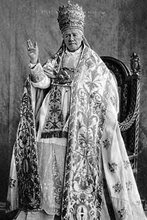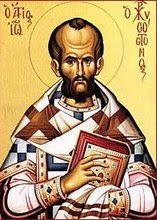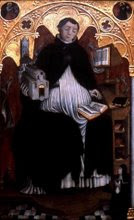An Introduction to Scholastic Philosophy
The philosophy of St. Thomas Aquinas was the marvel of the
Middle Ages and the crown jewel of Catholic scholarship. Yet, Aquinas’
philosophy was in many ways the culmination of 1,600 years of Greek philosophy.
Much to the boon of Christian philosophers at the time, the philosophy of
Aristotle was rediscovered during the Middle Ages after having been lost during
the downfall of the Roman Empire 1,200 years earlier. The philosophy of
Aristotle gave St. Thomas Aquinas and his contemporaries the tools they needed
to prove the reasonableness and rationality of the Catholic faith. This unique
blend of pagan wisdom (the philosophy of Aristotle) and revealed wisdom (the
Scriptures and teachings of the Church) was called Scholastic philosophy. The
most famous Scholastic philosophical work was St. Thomas Aquinas’ five-volume
treatise Summa Theologica. In the Summa Theologica, Aquinas used
the doctrines of the Church as a springboard for exploring the deepest questions
of philosophy.
Aristotle’s Definition of the Nature of Being and the
Material
Since scholastic philosophy relies on many of the principles of
Aristotle’s philosophy, it is necessary to explore Aristotelian principles
before delving into scholastic works such as Summa Theologica. Perhaps
the most important Aristotelian principle is the idea of being and an
understanding of what all things are composed of. In modern thinking the answer
to such questions as, "what is the nature of things?" seems simple. We are
taught at an early age that all things are composed of atoms, and that atoms are
the building blocks of all matter. Modern scientific teaching holds that the
nature of a human is strictly material; a man is nothing more than matter
(composed of atoms) and energy. Since science can show us that atoms truly exist
(we can see them in electron microscopes), and that we are composed of carbon
based molecules, water and electrolytes it seems reasonable to conclude that we
are strictly a collection of atoms and energy. Aristotle, however, did not buy
into this line of reasoning. Although some of his contemporaries believed that
the ultimate basis of being is atomistic, Aristotle believed that it was false
to say that being is defined only by the sum of its parts. The reason the
atomistic theory is fallacious is that the substantial form of a material or
being can not be located in any part of the substance (such as atoms, sub-atomic
particles, quarks, etc.) rather, parts such as atoms are predicated to an
already existing substance. In other words, something must be the basis of
material things, and simply subdividing the material into smaller and smaller
particles does not allow us define the nature of the material thing.
Therefore if we want to understand what a thing is in the
philosophic sense, we must define a thing as a whole before predicating parts
and quantity to it. Aristotle believed that when we ask the question "what is a
thing composed of?" or "what is the nature of a being or thing?" the answer lies
in the substance of that thing. Substance is a philosophic term
that is defined as the primary mode of being. All things are composed of a
substance. Therefore, the basis of reality lies in substances. Atoms and other
particles are real, yet they are only parts of the whole. This is why substance
is called the primary mode of being. Now, it is important to realize that
substance is not an imaginative concept, it is a rational concept. This means
that we can’t picture what a substance is in our imagination; rather we must use
rationality and logic to understand it.
In addition to the primary mode of being, substance, all
things have secondary modes of beings called accidents. Accidents are
those things that allow us to imagine a being or thing. Accidents inhere in a
substance and give it physicality. Aristotle defined ten categories of being
which allow us to answer the question, "what is a being or thing composed
of?"
The Ten Categories of Being
- Substance
- —Substance is the primary mode of being and defines what a
thing is. Substance is the foundation of reality and cannot be pictured in the
mind without also picturing the accidents that inhere in the substance.
The remaining categories of being are accidents: secondary modes of being.
- Quantity—
- quantity allows us to define the parts in a substance. For example, a tabby cat has two ears, two eyes and a multitude of atoms and genetic material.
- Quality—
- quality is a descriptive term such as, the softness and brown color of a tabby cat.
- Relation—
- relation identifies the relative state between two objects. For example, that tabby cat has the same color fur as the Angolan cat.
- Action—
- the action of the subject is also an accident. Action does not necessarily imply motion or change. For example, "the tabby cat is sitting still" is a valid action accident of the cat.
- Passion—
- In the philosophic sense, passion is defined as change. For example, we can say that the aging process of the tabby cat is a passion.
- Location—
- Location is also an accident. For example, we could say that an accident of the tabby cat is that it is sitting on top of the sofa.
- Posture—
- Posture identifies the spatial orientation of the subject. For example, we can say the tabby cat is sitting with all four feet on the floor and it’s tail is in motion.
- Temporality—
- Temporality is the affectation of time on the subject. For example, the tabby cat is seven years old.
- State—
- State seems to imply change in the subject which allows us to identify it from other subjects. For example, the tabby cat currently has both eyes closed and is falling asleep.
We can clearly see that nine of the ten states of being are
accidental. Yet, only the primary mode of being, the substance, defines a being
or object. For example, we could say that the length of President Bush’s hair is
a quantitative accident. If he were to cut his hair there would be a change to
his accidental qualities (the length of his hair), but he would still be
President Bush because his substance has not changed. We should also note that
accidents do not exist separately from a substance. Rather, they inhere in a
substance. The length of someone’s hair does not exist separately from a person.
Therefore, no substance can be imagined without its inherent accidents and no
accident can exist separately from a substance.
Potentiality and Actuality
The concept of potentiality and actuality is
critical to scholastic philosophy. Actuality and potentiality are opposites that
describe the state of a substance. Actuality describes the exact form, state,
position and the rest of the ten categories of being as they apply to some
object. If we use the tabby cat example, we can say that the categories of being
such as the cat’s posture, location, qualitative properties, quantitative
properties, etc. actualize the cat. In other words, the cat is
actual simply because it exists. However, the cat not only has
actuality, it also has potentiality. The cat is capable of
changing any of its accidents by simply moving, shedding fur, aging or even
changing its substance (such as when the cat changes from a living cat into a
corpse after death). In this sense, we say that the cat has a potential
to change. All material things have both actuality and potentiality simply
because of their virtue to change.
The reason the concept of potentiality and actuality is
important to scholastic philosophy is because it is the central pillar in Saint
Thomas Aquinas’ cosmological proof for the existence of God. Consequently, an
understanding of the Aristotelian concepts of potentiality and actuality is
necessary for scholastic and Christian philosophers.
Prime Matter and Substantial Form
Now that we understand the difference between a substance and
an accident as well as the ten categories of being, we can attempt to further
understand what exactly a substance really is. Aristotle believed that a
substance is composed of prime matter and form. Prime
matter is not the same thing as physical matter (the kind we usually think
of as composed of atoms). Instead, prime matter should be thought of in terms of
potency and actuality. Prime matter is nothing more than pure potency. It is the
substantial underlying reality of all things, and as such, has the potential to
become anything. Prime matter (since it is substantial) has no physical
appearance, quality or quantity. Prime matter cannot even be thought of separate
from form. Form is what allows prime matter to become substance.
For instance, all of the elements on the Periodic Table (such as iron, gold,
silver, mercury, etc.) can be thought of as comprised of prime matter. The thing
that differentiates the elements from each other is their form. Silver
and gold are composed of the same prime matter but have different form. Form and
prime matter constitute the substance of any object, and the substance of that
object is inhered with accidents that give the substance a physical
character.
Substantial Changes vs. Accidental Changes
We have already learned that the accidents of any object
can change. An accidental change of this nature does not affect the substance of
the object. If a cat changes its posture, its accident of location changes, yet
it is still a cat. A change of accident will not cause the cat to become
anything else.
However, there can be changes to the substance of an object. If
an object’s form were to change, then the object’s substance would likewise
change. This type of change is called a substantial change. For example,
if a cat were to walk off a cliff and fall 60 feet to its death, it would
undergo both an accidental change (due to the change of the cat’s posture and
location) and a substantial change (caused by the death of the cat). We can no
longer call the cat a living animal; instead it has substantially changed into a
corpse. A similar thing occurs in chemical reactions. If a substance such as
iron were to combine with oxygen, the iron would become iron oxide: rust. The
change from iron to rust involves a substantial change in the form of the iron.
The oxidation process renders a change in the substance of the iron into
something new.
Critique
One criticism to Aristotle’s unique view of the world is
perhaps the fact that modern science seems to view the world in a substantially
different manner. It can be argued that in the example of the cat, the feline
DNA comprises the real nature of the cat; not some strange idea such as
substance. In other words, the parts determine the whole. However, this
view, mechanistic materialism, is fundamentally flawed. If we were to
appeal to DNA as the fundamental reality of the cat (as if DNA was a building
block for the cat) we would still need to explain the parts of the DNA.
Otherwise, how do we explain what these parts are if DNA is the prime building
block of the cat? A mechanist materialist would probably then appeal to the atom
as the prime building block of DNA and hence the cat. Of course, atoms are
composed of sub-atomic particles, which demand explanation. These particles are
also made of sub-particles, and so on… Eventually, the materialist must arrive
at some particle which is the fundamental reality of the cat; the one thing that
makes the cat real. However, even if he were to stop his sub-atomic chain at
such a particle (such as pure energy or super-strings) he would still have to
explain where the particle derives its "reality". In this event, the materialist
would just admit that the energy particle (for arguments sake lets call it a
super-string) just is real; it has no explanation for itself and must be
a completely simple reality. If he did this he would find himself agreeing with
Aristotle. Why? The reason is that the materialist will have agreed that the
super-string is a fundamental reality. The super string has mass, quality (such
as brightness or texture), quantity and possibly other modes of existence called
accidents by Aristotelian thinkers. The materialist must agree that the
fundamental particle (the super-string) has accidents, otherwise where does the
quantity, quality, position, posture, etc. of the cat come from? If the
materialist agrees to the fact that the super-string is a fundamental reality
with accidental qualities, then he has just defined an Aristotelian
object. His object has substance (a primary mode of being which
fundamentally just is) inhered with accidents (secondary modes of
being which give the substance discernable characteristics). In the end,
the materialist will be forced to admit the reality of substance and
accidents over the philosophy of an endless string of mechanistic
materialism. We can also simply say that the cat just is a simple
substance inhered with accidents that are divisible into parts (DNA,
proteins, atoms, quarks, super-strings, etc.) The cat is defined as a whole
rather than a sum of parts. The cat is fundamentally composed of primary matter
with the form of a cat. The parts (such as cat DNA and its constituent atoms)
are also feline since the form of the cat is inherent in every part of the cat.
The substance of the cat determines the parts to be what they are. An individual
atom separate from the form of the cat is substantially different because the
substance of the atom is atomic, but an atom in a cat is only part of the whole:
therefore its substance is feline. The bottom line is that a whole must be
defined first before parts can be predicated to it.
I will leave the reader with one last example to drive home the
difference between the mechanistic materialist view of matter and the Scholastic
view of matter. Certainly, most of us have learned from science that an atom is
almost entirely composed of empty space; there is very little material in the
atom (protons, neutrons and electrons). Rather, the mass of the atom is
constituted in the nucleus and the majority of the atom is an empty void with
electrical charges (electrons) orbiting the nucleus. A materialist will often
point out that a solid object such as a table is nearly entirely composed of
empty space due to the spacing of the mass particles in the atoms. The question
which remains unresolved is then why does the table seem qualitatively solid (it
has color, weight, firmness) if it is composed only of empty space with
comparatively tiny subatomic particles? The quality of the table cannot come
simply from the quantity of the parts. This suggests that the table is
essentially prime matter and form which has the secondary properties of quality
and quantity.
Conclusion
Aristotle’s philosophy is latent in the works of the
Scholastic philosophers. The idea of substance and accidents form the basis for
the Christian metaphysical understanding of the world. St. Thomas Aquinas and
his peers use the metaphysics of Aristotle to explore everything from the nature
of man to the nature of God. Additionally, Aristotle’s ideas of actuality and
potentiality are manifest within the Scholastic understanding of causation and
the creation of the Universe. For the Scholastics, it seems that a great debt is
owed to Aristotle. It was in Aristotle, that the philosophers first truly
learned to seek for wisdom in the intellect rather than the imagination and
sought for knowledge in rationality without limiting themselves to the world of
sensation.
--S.M. Miranda




















No comments:
Post a Comment